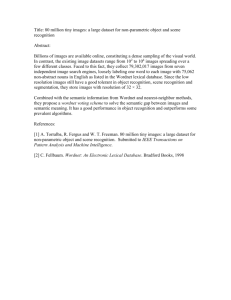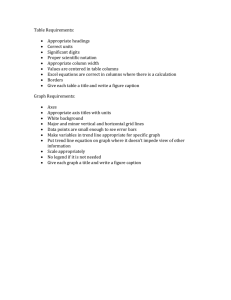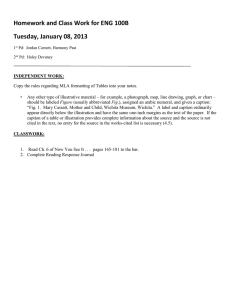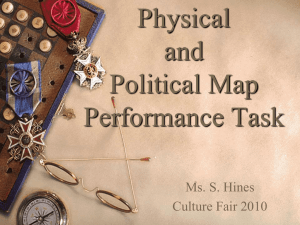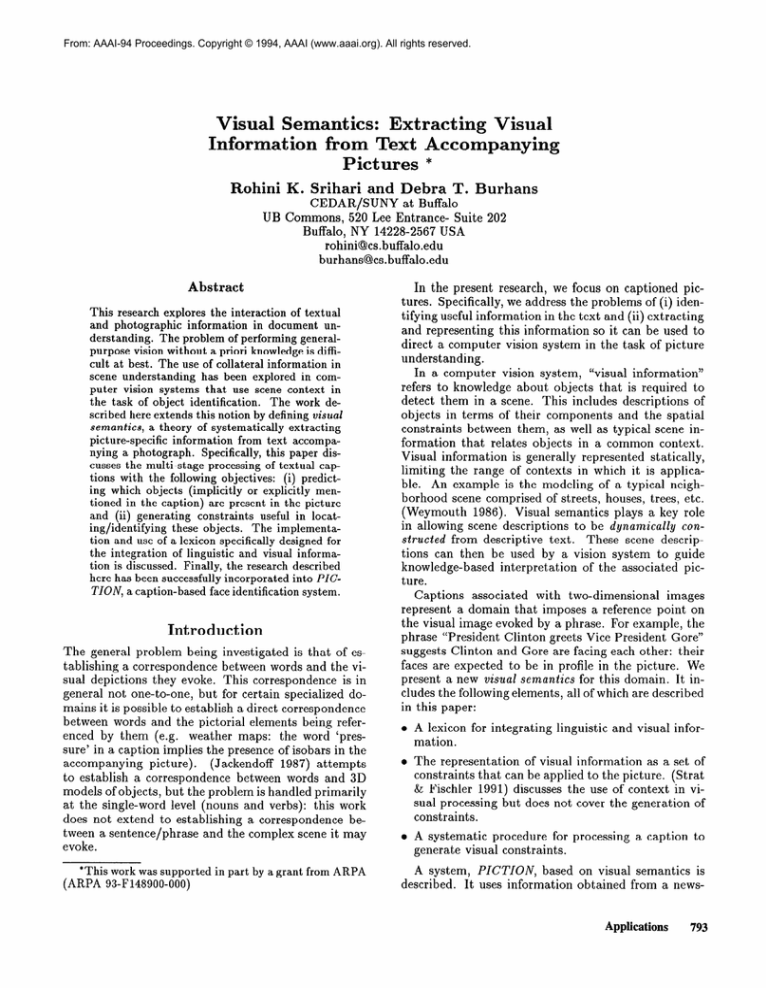
From: AAAI-94 Proceedings. Copyright © 1994, AAAI (www.aaai.org). All rights reserved.
Visual Semantics: Extracting Visual
Informat ion from Text Accompanying
Pictures *
Rohini K. Srihari and Debra T. Burhans
CEDAR/SUNY at Buffalo
UB Commons, 520 Lee Entrance- Suite 202
Buffalo, NY 14228-2567 USA
rohini@cs.buffalo.edu
burhans@cs.buffalo.edu
Abstract
This research explores the interaction
of textual
and photographic
information
in document
understanding.
The problem of performing generalpurpose vision without a priori knowledge is difficult at best. The use of collateral information
in
scene understanding
has been explored in computer vision systems
that use scene context
in
the task of object identification.
The work described here extends this notion by defining visual
semantics, a theory of systematically
extracting
picture-specific
information
from text accompanying a photograph.
Specifically, this paper discusses the multi-stage
processing of textual captions with the following objectives:
(i) predicting which objects (implicitly
or explicitly mentioned in the caption)
are present in the picture
and (ii) generating
constraints
useful in locating/identifying
these objects.
The implementation and use of a lexicon specifically designed for
the integration
of linguistic and visual information is discussed.
Finally, the research described
here has been successfully incorporated
into PICZ’ION, a caption-based
face identification system.
Introduction
The general problem being investigated is that of establishing a correspondence between words and the visual depictions they evoke. This correspondence is in
general not one-to-one, but for certain specialized domains it is possible to establish a direct correspondence
between words and the pictorial elements being referenced by them (e.g. weather maps: the word ‘pressure’ in a caption implies the presence of isobars in the
(Jackendoff 1987) attempts
accompanying picture).
to establish a correspondence between words and 3D
models of objects, but the problem is handled primarily
at the single-word level (nouns and verbs): this work
does not extend to establishing a correspondence between a sentence/phrase and the complex scene it may
evoke.
*This work was supported
(ARPA
93-F148900-000)
in part by a grant from ARPA
In the present research, we focus on captioned pictures. Specifically, we address the problems of(i) identifying useful information in the text and (ii) extracting
and representing this information so it can be used to
direct a computer vision system in the task of picture
understanding.
In a computer vision system, “visual information”
refers to knowledge about objects that is required to
detect them in a scene. This includes descriptions of
objects in terms of their components and the spatial
constraints between them, as well as typical scene information that relates objects in a common context.
Visual information is generally represented statically,
limiting the range of contexts in which it is applicable. An example is the modeling of a typical neighborhood scene comprised of streets, houses, trees, etc.
(Weymouth 1986).
Visual semantics plays a key role
in allowing scene descriptions to be dynamicaddy constructed from descriptive text. These scene descriptions can then be used by a vision system to guide
knowledge-based interpretation of the associated picture.
Captions associated with two-dimensional images
represent a domain that imposes a reference point on
the visual image evoked by a phrase. For example, the
phrase “President Clinton greets Vice President Gore”
suggests Clinton and Gore are facing each other: their
faces are expected to be in profile in the picture. We
present a new visual semantics for this domain. It includes the following elements, all of which are described
in this paper:
e A lexicon for integrating linguistic and visual information.
o The representation of visual information as a set of
constraints that can be applied to the picture. (Strat
& Fischler 1991) discusses the use of context in visual processing but does not cover the generation of
constraints.
o A systematic procedure for processing a caption to
generate visual constraints.
A system, PICTION,
based on visual semantics is
described. It uses information obtained from a news-
Applications
793
”
(b)
I
SEANPENN.out
TOUK.IESMITH.out
Sean Penn, left, and Robert DeNiro pose with Toukie Smith, sister
Figure 1: (a) photograph with caption “
of the late fashion designer Willi Smith, at a New York celebrity auction Sunday in memory of Smith (The Bu$alo
News, Feb. 27, 1989); (b) output of face locator; (c,d) output of PICTION.
paper caption to label faces in the accompanying photograph.
This research is most relevant in the context of document image understanding. Pictures with captions
are ubiquitous in documents, newspapers and magazines. The information contained in both pictures and
captions enhances overall understanding of the accompanying text, and often contributes additional
mation not specifically contained in the text. This
information could subsequently be incorporated into
an integrated text and picture database that permits
content-bused
retrieval.
A Caption-based
Identification System
PICTlOik
Face
We refer to a caption and its associated picture in a
newspaper as a communicative
unit. Given a text file
corresponding to a newspaper caption and a digitized
version of the associated photograph, PICTION (Srihari 1994; 1991) is able to locate, label, and give information about objects referred to in the communicative
unit. PICTION was initially tested on a database of 50
pictures. It successfully and uniquely identified faces
in 62% of the cases, and achieved partial success on an
addition 11% of the pictures.
PICTION
provides a computationally less expensive alternative to traditional methods of face recognition. These methods employ model-matching techniques: only people for whom pre-stored face models
794
Natural Language Processing
exist can be identified. In PICTION faces are identified based solely on visual information conveyed by
accompanying text. A key component of PICTION is
the face locator, which locates (but cannot recognize)
human faces in photographs.
Figure 1 is an example of a digitized newspaper
photograph and accompanying caption that the system successfully processes.
The male/female filter
is not able to distinguish between Toukie Smith and
Robert DeNiro, leading to multiple possible bindings.
Sean Penn is identified correctly based on spatial constraints.
Figure 2 shows the overall control structure of PICarTION. The three main components of PICTION
chitecture are (i) a natural-language processing (NLP)
module, (ii) an image understanding (IU) module, and
(iii) a language-image interface (LII). The NLP and IU
modules interact through the LII which maintains the
long-term knowledge base (LTM). PICTION runs on a
Sun Sparcstation. It has been implemented primarily
in LOOM(ISX 1991), an environment for constructing
knowledge based systems, with a LISP interface to visual routines written in C.
The NLP module (illustrated in Figure 2) is divided
into three stages: syntactic parsing, partial semantic
interpretation (PSI) and caption based constraint generation (CBCG). The input to the NLP Module is the
original newspaper caption; the output is a set of visual constraints. The LII module converts the visual
information into a series of directives for the IU module
NLP
-mm-)
LII Module
Module
Con fro/
b
Data
Figure 2: PICTION
which is then called on to interpret the picture. The
IU module has several features which enable it to be
guided by the LII, including: constrained search, ability to characterize objects, crude and refined objectlocation procedures, ability to change parameters and
repeat actions, output compatibility with intermediate
representation, and the ability to perform bottom-up
interpretation when necessary. Information is consolidated in the LII by satisfying various types of constraints. This may require repeated calls to the IU
module.
The remainder of this paper focuses on the NLP
module, namely, the processing of the caption.
Lexical Database
uses a broad coverage syntactic/semantic
lexical database which has been constructed from the
following sources: (i) Longman Dictionary of Contemporary English (LDOCE), (ii) Oxford Advanced
Learner’s Dictionary (OALD), (iii) WordNet (Beckwith et al. 1991) (iv) name lists ’ and (v) manual
augmentation (ontological information and visual semantics). This is similar to work done on the Penman
Project at IS1 (Knight & Luk 1994).
A LOOM knowledge base instance is constructed for
each word in the lexicon. Name instances contain information on gender; word instances contain syntactic and semantic information from LDOCE (including subject field codes, semantic restrictions and verb
subcategorization),
morphological information from
OALD and pointers to concepts representing WordNet
PICTION
‘These lists were obtained from the Consortium
ical Research at New Mexico State University.
for Lex-
System Overview
synsets. WordNet synsets are represented as LOOM
concepts organized in a hierarchy that mirrors WordNet. Synset concepts contain part-of, is-part and verb
classification information from WordNet. Visual and
procedural semantic properties have been added manually to a subset of the concepts.
Our approach uses and extends the Naive Semuntics (Dahlgren 1988) model (a theory of associating
commonsense knowledge with words). An upper level
ontology that is based on Naive Semantics and extends
the WordNet hierarchy is incorporated into the lexicon.
It is necessary to represent fixed, visual properties
of objects, such as size and color, as well as procedural information for certain words and phrases. For
example, a recent caption identified one of the people
in the corresponding photograph as “the person wearing the hat”. This should generate a call to an object
finder with the location “above head”, and the scale
and shape properties of the object (hat).
IHAT is the name of the lexical instance for the word
“hat” (Figure 3). It contains information from the
LDOCE and a pointer to the corresponding WordNet
synset concept. “WNN0206338” represents information from WordNet. Synonyms for hat include “chapeau” and “lid” ; “WNN02066195” is the superconcept of “hat”. The “scale”, “shape” and “function”
slots have been manually instantiated and are used
to generate visual information. Procedural information stored with the “wear” synset specifies that if the
event “wear” is associated with “hat”, and the subject
of “wear” is a human, a typical location for hat is on
the head of the associated person. The CBCG uses
this information to generate a locative constraint (deApplications
795
(tellm (:about IHAT
:is-primitiveLDOCEconcept
(WNsynsetWNNO206338)
(noun-partLD0030091)))
(defconceptWNN0206338
:is-primitiveWNN02066195
:annotations
((word-list(hat chapeau lid))
(scale 92)
($semantic-feature
$clothing)
(has-part(brim crown hatband))
(shape
(procedure
(find-shape(crown,cylinder,hollow))
(find-shape(brim,disc))
(top-of(crown,brim))))
(function
(wear(E,nonn,Y)
& human(Y)
& typ-location(E,noun,
procedure(locate-in-vicinity
(nonn,top-of(locate-partchead(Y))))))))))
Figure 3: Partial lexicon generation code for the word
“hat”
scribed later) which is subsequently used by the LII
and the vision module to identify the person wearing
the hat.
Visual
Hierarchies
We have defined visual hierarchies in terms of visual
superconcepts
which reflect type (man-made, natural),
shape, texture properties, boundary properties etc. of
an object. New links (visual-is-a, visual-part-ofl have
been added between existing WordNet synsets (representing concrete objects) and these superconcepts.
Specialized attributes such as size, color, expected lo-
q
WordNet concepts
0
visual concepts
-tb
visual is-a
-+
visual has-part
--*
is-a
--B
has-part
classes
(e.g.,
human face, tree, building, car) to be appropriately invoked. 2
There are many objects for which it is difficult to
construct detailed shape descriptions. In these cases
itissufficient
to statesome of theirproperties
such as
natural/man-made,boundary description,
etc. Identification
of theseobjectsis based on a blob theoryof
objectrecognition:
usingconstraints
that specify size,
expected location and a few object properties, the object can be roughly located, which is sufficient for our
purposes.
For example, consider a picture of a man holding
a trophy accompanied by the caption “Thomas Smith
holding the trophy he won at . . .“. To identify the
trophy, the system would first find the face of Thomas
Smith, then search in the appropriate vicinity for an
object exhibiting the required properties (man-made,
small-medium size, etc.).
Our representation allows objects to be modeled at
various resolutions. For example, at the most general
level, a tree is a natural object with a fractal boundary. A more detailed visual model of tree defines the
visual parts of a tree as well as the spatial relationships
between these parts. These parts are classified according to the chosen set of visual superconcepts. At the
most specific level, the description of a tree includes a
specialized recognition module for trees.
The has-part information in visual object models
may differ from the has-part information used in WordNet for the following reasons: (i) the has-part information in WordNet may be too fine-grained to be
exploited by a vision system (e.g., shoes can have
laces), and (ii) the names of the parts may differ (e.g.,
the WordNet entry for ‘tree’ includes crown, trunk,
branches and stump, however the visual description
for tree will have a treetop and a trunk). This is illustrated in Figure 4.
A study in human cognition regarding the task of
identifying objects reveals that there is justification for
having different abstractions for words and pictures.
(Linde 1982) postulates the existence of two separate
semantic-memory representations. (Jolicoeur, Gluck,
& Kosslyn 1984) states that both words and pictures
may use the same semantic-memory representation;
they differ however in the entry point, namely the particular level of abstraction in the hierarchy at which
the association is made.
Parsing
Pre-Processing
Figure 4: Visual hierarchy superimposed on WordNet
concept hierarchy.
cation, etc. are added at the synset level. This visual information allows recognition tools (such as segmentation tools, edge detectors, surface detectors) and
specialized object detectors for certain common object
796
Natural Language Processing
Input
There are two objectives to this phase. The first is the
elimination of directive phrases such as “left-of”, “front
row, left to right”, etc. Directive phrases are associated
with appropriate noun phrases and passed directly to
2According
to (Biederman
19SS),there are about 3000
common
entry-level
objects which the human perceptual
system can detect.
the CBCG for further processing. The second objective of pre-processing is the detection and classification
of proper noun sequences, which frequently contain unknown words. In this example from The Bufludo News,
the proper noun sequences are bracketed:
[Vladimir Horowitz] at [Steinway and Sons],
[New York], . . .
“Vladimir Horowitz” is classified as a name, “Steinway
and Sons” as an organization name and “New York”
as a geographic location.
A hidden Markov model, trained on a portion of the
Penn Treebank corpus, is used to detect proper noun
sequences. We are currently able to detect proper noun
sequences with about 90% accuracy. Proper noun lists
containing appropriate classification information (gender, location, organization, etc.) 3 and heuristic rules
(involving typical suffixes such as “Inc.“) are employed
in the categorization of proper nouns. Correct classification of proper noun sequences still poses a significant
challenge (Mani et al. 1993).
LFG Parser and Partial
Interpretation
Semantic
An LFG which covers basic features of English grammar has been compiled into an LR parsing table.
We employ an efficient LR parser augmented by
pseudo/full unification packages (Tomita 1987). Certain semantic features (e.g., animate/inanimate; features associated with proper nouns) are incorporated
into the output structure of the parser. This semantic
information is obtained solely through lexicon lookup
and is used to help disambiguate among multiple syntactic structures output by the parser. We are experimenting with statistical techniques for handling
prepositional phrase and word sense disambiguation.
Anaphoric references are resolved by the use of weights
assigned to various referents depending on their role in
the sentence.
Caption-based
Constraint
(CBCG)
Generator
Input to the CBCG is the disambiguated parse from
the PSI stage; output is a set of visual constraints to
be used by the IU module. The CBCG makes use of
the LTM in the LII for retrieval of information about
well-known people, as well as the lexicon, for assigning
visual semantics to the parse.
Constraint
Types
Using visual information derived from text, PICTION
hypothesizes a set of objects expected to be in the picture and constraints on those objects. Constraints are
divided into four types:
can be binary or n-ary, and describe inter-object
relationships. Complex spatial constraints such as
“surround” are broken down into a set of constraints
based on spatial primitives.
constraints
express information about
the location of objects in the picture with respect
to a particular frame of reference. The information conveyed is procedural in nature, for example,
if you are told there is a chair in the corner, it results in the following high-level procedure construct:
Locative
lot-in-vicin(chair,
region(corner(entire-image))).
are unary constraints
which describe properties of objects. Examples include gender and hair color.
Characteristic
Constraints
Contextual
Constraints are those which describe
the setting of the picture, and the objects which are
expected to appear. Examples include the people
present (mentioned in the caption), whether it is
an outdoor scene, and general scene context (apartment, airport, etc).
Some visual constraints are expressed explicitly
as assertions, for example left-of(person-a
person-b).
Locative and characteristic constraints are implicit in
the object model. Contextual constraints consist of
the instantiated objects and an asserted general scene
context.
Consider the photograph and caption of Figure 1.
Some of the constraints output by the CBCG for this
example are:
SPATIAL:left-of(SeanPenn ,RobertDeNiro)
adjacent(Robert DeNiro , Toukie Smith)
CHARACT:has,prop(name:Sean
Penn;gender:male)
has,prop(name:Toukie
Smith;gender:female)
“Adjacent” is asserted as the default spatial constraint.
Automatic
Constraints
Generation
of Visual
The CBCG has been written as a rule-based system
which uses LOOM concepts to drive the semantic
“parsing”. LOOM methods and rules are invoked when
particular concepts are instantiated.
There are three main categories of rules.
Word-based:
Spatial and characteristic constraints are frequently
indicated by single words. Examples include left,
right, above and below, as well as characteristics
such as hair color and titles like President.
Phrase- based:
0 Spatial
Locative and characteristic constraints are often indicated by directive phrases. Examples include “between the two buildings” and “wearing the striped
shirt” .
3These lists were obtained from the Consortium for Lexical Research at New Mexico State University.
Contextual constraints can generally be inferred at
the sentence level, taking into account the various
Constraints
are geometric or topological
constraints, such as left-of, above, inside, etc. They
Sentence- based:
Applications
797
objects mentioned and their relations and properties. An example of this is the “SVOPP” rule which
states that if the sentence is of the form subjectverb-object-prepositional-phrase,
and both the subject and object represent humans, and the PP represents a time and/or location, then propose that both
the subject and the object are in the picture.
The top-level rules are based on syntactic structure
and attempt to predict which people (or objects) are
in the picture. Verifying the antecedents of these rules
(e.g., is the person deceased?) causes other rules to
be fired. The final action is to generate identifying
information for every person/object predicted to be in
the picture.
Consider the caption “Actors Sean Penn, left, and
Robert DeNiro pose with Toukie Smith, sister of the
late fashion designer Willi Smith, at a New York
celebrity auction Sunday”. All three people mentioned
will be predicted to be in the picture as the sentence has the form <subject-list> <verb> <object>
<adverbial place> <adverbial time>.
A concept and the associated production rule used
to generate the contextual constraint that the picture
is indoors are as follows:
(defproductionis-indoor
:when (:detects(inside?parse ?cg>)
:perform(tell (:about?cg (location'indoor))))
(defconceptinside
:is (:predicate(?parse)
(let ((?flat (explode?parse))
(semfeatsnil>>
(dolist (?x ?flat)
(push (get-sem-features
?x) ?semfeats))
(or (memberp '$indoor?semfeats)
(and (memberp'$social-event
$semfeats)
(not (memberp$outdoor?semfeats>))>))>
The photograph in Figure 1 is predicted to be of an
indoor scene since “auction” has the semantic feature $social-event
stored in the lexicon, and there
is nothing mentioned which has the semantic feature
of being outdoors. The fact that Toukie Smith is female is inferred by the presence of the word “sister” in
the directional phrase associated with her name. The
spatial constraints shown in the previous section are
generated when spatial constraint rules are fired.
Summary
This paper has presented a new theory of visual semantics that concerns the use of descriptive text in the interpretation
of accompanying photographs.Although
the examples used are from captioned newspaper photographs, and the application is knowledge-based vision, this work can be extended to any domain where
both language and pictures are used to communicate
information. A highlight of this work is the development of a lexicon that includes visual hierarchies, as
well as a systematic procedure for generating visual
constraints from text accompanying a picture.
798
Natural Language Processing
References
Beckwith, R.; Fellbaum, C.; Gross, D.; and Miller,
6. A. 1991. WordNet: A Lexical Database Organized on Psycholinguistic Principles. In Lexicons: Using On-line Resources to Build a Lexicon. Lawrence
Erlbaum.
Biederman, I. 1988. Aspects and extensions of a
theory of human image understanding. In Pylyshyn,
Processes in Human Vision:
Z., ed., Computational
An interdisciplinary
perspective. Ablex.
Dahlgren, K.
Language
1988.
Naive Semantics
for Natural
Understanding.
Boston: Kluwer Academic
Press.
ISX Corporation.
1991. LOOM
Users Guide,
Version
1.4.
Jackendoff, R. 1987. On Beyond Zebra: The Relation of Linguistic and Visual Information. Cognition
26(2):89-114.
Jolicoeur, P.; Gluck, M. A.; and Kosslyn, S. M. 1984.
Pictures and Names: Making the Connection. Cognitive Psychology 16:243-275.
Knight, K., and Luk, S. 1994. Building a Large Scale
Knowledge Base for Machine Translation. Forthcoming. In Proceedings of AAAI-94.
Linde, D. J. 1982. Picture-word differences in decision latency. Journal of Experimental
Psychology:
Learning,
Memory
and Cognition
8:584-598.
Mani, I.; MacMillan, T. R.; Luperfoy, S.; Lusher,
E. P.; and Laskowski, S. J. 1993. Identifying Unknown Proper Names in Newswire Text. In Proceedings of the Workshop on Acquisition
edge from Text, 44-54.
of Lexical Ir’nowl-
Srihari, R. K. 1991. PICTION: A System that Uses
Captions to Label Human Faces in Newspaper Photographs. In Proceedings of AAAI-91, 80-85. AAAI
Press.
Srihari, R. K. 1994. Use of Collateral Text in Understanding Photos. Forthcoming. Artificial Intelligence
Review. Special Issue on Integration of NLP and Vision.
Strat, T. M., and Fischler, M. A. 1991. ContextBased Vision: Recognizing Objects Using Information from Both 2-D and 3-D Imagery. IEEE PAMI
13( 10):1050-1065.
Tomita, M. 1987. An Efficient Augmented-contextLinguistics
Free Parsing Algorithm. Computational
13( l-2):31-46.
Weymouth, T. 1986. Using Object Descriptions
in a
Schema Network for Machine Vision. Ph.D. Dissertation, University of Masschussetts at Amherst.

